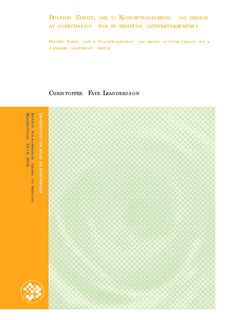| dc.description.abstract | This project is based on a prospective concept developed by Professor Jan Kåre Bøe at UMB, IMT. The purpose is to develop a three-wheeled lightweight vehicle based on the delta-principle with two wheels on the back and one in front.
It is plausible that, in the future, there will be even more stringent requirements and restrictions regarding emissions and energy usage when it comes to transportation of goods and people. Hence, vehicles must become smaller and lighter in weight. On this basis, this project was done to create a design for a vehicle over-chassis. The over-chassis is based on an under-chassis and interior already developed by Jan Fredrik Aasheim [16.1.1] and Magnus Ottesen [16.1.2], respectively.
This projects main goal is to conceptualize and develop a shape-design for the over-chassis on the lightweight vehicle Dolphin Family. To create an appealing, future-oriented and modern design, form-and design study will be emphasized. There will also be performed a flow analysis to establish the vehicle drag coefficient.
To achieve a satisfactory result, a seemingly logical and structured process was used. A background research on existing models was performed to identify potential characteristics and designs for further use in the design-process. It became clear from this research that the trend leans towards a model that is narrow in front, and gradually becomes wider towards the back-tires; a natural result given the tire-setup based on the delta-principle. At the rear of the car, the shape becomes narrower to form a smooth and efficient looking drop-shape. This drop shape is, first and foremost, what was used as the “building-block” in the shape-study and concept evaluations.
Before the different design-concepts were made, a study on the car-shape development from 1960 until today was performed. This study yielded a certain “picture” of how a future design might look like. As a result of this research and own interpretations, it was decided that a future-oriented design should be aerodynamic and that it should consist of a combination of organic as well as inorganic shapes and details. Also, there has been performed small study on how one can use a combination of different basic geometrical shapes to create a variety of more complex designs.
To decide on the final design to be used in the further modeling and flow-analysis, a concept evaluation of the vehicle’s general shape was performed. Thereafter, a more in-depth analysis for shaping of windows, frontal view, mirrors and doors was performed.
The final selected design was modeled in a 3D-program called SolidWorks. By creating a 3D-model of the vehicle, it was easier to properly visualize how the final product will actually look like. Also, the 3D-model was used for the flow analysis performed to calculate and estimate the drag coefficient, Cd. The technique utilized for the modeling is called “surface-modeling”, a technique in which outside borderlines are drawn before “filling” the surface in. This was a new technique for modeling and required quite some effort and learning to finish the model. Due to modeling problems in some aspects of “surface-modeling”, certain deviations between the design-drawings and the 3D model are present.
For the flow analysis, a plug-in in SolidWorks, called FlowSimulation, was used. Because of issues with importing the complete model, only the most critical part of the model was used and tested in the simulation. The actual analysis was performed at three different speeds, 10 m/s ≈36 km/t, 15 m/s ≈ 54 km/t and 25 m/s ≈ 90 km/t. Further, the static pressure was set to 101325 Pa and the temperature was set at 20 °C. The average Cd-value of the three simulations was 0,247; a good result as the value lies within the preferred interval of 0,20 – 0,26. | no_NO |
